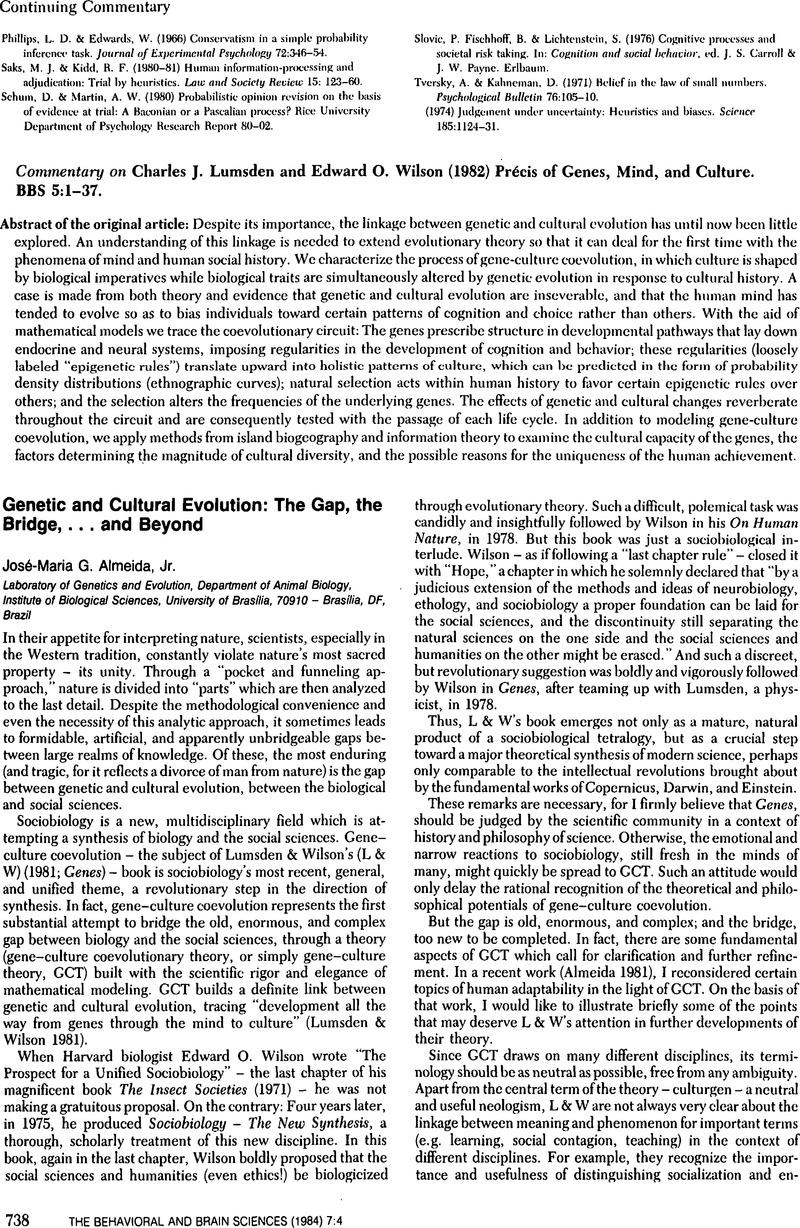No CrossRef data available.
Article contents
Mathematical models for gene–culture coevolution
Published online by Cambridge University Press: 04 February 2010
Abstract
An abstract is not available for this content so a preview has been provided. Please use the Get access link above for information on how to access this content.

- Type
- Continuing Commentary
- Information
- Copyright
- Copyright © Cambridge University Press 1984
References
Almeida, J. M. G. Jr, (1981) Gene-culture coevolution and human adaptability. To be published in Annals of the Second Brazílian Meeting on Human Ecology. [JMGA]Google Scholar
Alper, J. S. & Lange, R. V. (1981) Lumsden-Wilson theory of gene-culture coevolution. Proceedings of the National Academy of Sciences, U.S.A. 78:3976–79. [JSA]CrossRefGoogle ScholarPubMed
Block, J. (1981) Some enduring and consequential structures of personality. In: Further explorations in personality, ed. Rabin, A. I., Aronoff, J., Barclay, A. M. & Zueker, R. A.. Wiley. [JPR]Google Scholar
Bouchard, T. J. & McGue, M. (1981) Familial studies of intelligence: A review. Science 212:1055–59. [JPR]CrossRefGoogle ScholarPubMed
Carey, G., Goldsmith, H. H., Tellegan, A. & Gottesman, I. I. (1978) Geneties and personality inventories: The limits of replication with twin data. Behavior Genetics 8:299–313. [JPR]CrossRefGoogle Scholar
Cattell, R. B. (1962) The personality and motivation of the researcher from measurements of contemporaries and from biography. In: Scientific creativity: Its recognition and development, ed. Taylor, C. W. & Barron, F.. Wiley. [JPR]Google Scholar
Eaves, L. J. & Eysenck, H. J. (1974) Genetics and the development of social attitudes. Nature 249:288–89. [JPR]CrossRefGoogle ScholarPubMed
Eysenck, H. J. & Eysenck, S. B. G. (1976) Psychoticism as a dimension of personality. Hodder & Stoughton. [JPR]Google Scholar
Falconer, D. S. (1966). Genetic consequences of selection pressure. In Genetic and environmental factors in human ability, ed. Meade, J. E.Parkes, A. S.. Oliver and Boyd. [AV]Google Scholar
Fararo, T. J. (1978) Mathematical sociology: An introduction to fundamentals. Robert E. Krieger [rCJL]Google Scholar
Floderus-Myrhed, B., Pedersen, N. & Rasmuson, I. (1980) Assessment of heritability for personality, based on a short-form of the Eysenck Personality Inventory: A study of 12, 898 twin pairs. Behavior Genetics 10:153–62. [JPR]CrossRefGoogle Scholar
Gray, J. A. (1982) The neuropsychology of anxiety: An enquiry into the functions of the septo-hippocampal system. Oxford University Press. [JPR]Google Scholar
Hendrickson, D. E. & Hendrickson, A. E. (1981) The biological basis of individual differences in intelligence. Personality and Individual Differences 1:3–34 [JPR]CrossRefGoogle Scholar
Kaffman, M. (1977). Sexual standards and behavior of the kibbutz adolescent. American Journal of Orthopsychiatry 47:207–17. [AV]CrossRefGoogle ScholarPubMed
Kagan, J. & Moss, H. A. (1962) From birth to maturity: A study in psychological development. Wiley. [JPR]CrossRefGoogle Scholar
Loehlin, J. C. & Nichols, R. C. (1976) Heredity, environment, and personality. University of Texas Press. [JPR]Google Scholar
Lumsden, C. J. & Wilson, E. O. (1980a) Gene-culture translation in the avoidance of sibling incest. Proceedings of the National Academy of Sciences, U.S.A. 77:6248–50. [JSA]CrossRefGoogle ScholarPubMed
Lumsden, C. J. & Wilson, E. O. (1980b) Translation of epigenetic rules of individual behavior into ethnographic patterns. Proceedings of the National Academy of Sciences, U.S.A 77:4382–86. [JSA]CrossRefGoogle ScholarPubMed
Lumsden, C. J. & Wilson, E. O. (1981) Genes, mind, and culture: The coevolutionary process. Harvard University Press. [JMGA, JSA, CJL, JPR]Google Scholar
Lumsden, C. J. & Wilson, E. O. (1982a) Genes and culture, protest and communication. Behavioral and Brain Sciences 5:31–35. [JSA, AV]CrossRefGoogle Scholar
Lumsden, C. J. & Wilson, E. O. (1982b) Précis of Genes, mind, and culture. Behavioral and Brain Sciences 5:1–37. [JSA, AV]CrossRefGoogle Scholar
Miller, J. Z. & Rose, R. J. (1982) Familial resemblance in locus of control: A twin-family study of the Internal-External Scale. Journal of Personality and Social Psychology 42:535–40. [JPR]CrossRefGoogle Scholar
Osborne, R. T., Noble, C. E. & Weyl, N. eds. (1978) Human variation: The biopsychology of age, race, and sex. Academic Press. [JPR]Google Scholar
Owen, D. R. & Sines, J. O. (1970) Heritability of personality in children. Behavior Genetics 1:235–48. [JPR]CrossRefGoogle ScholarPubMed
Rushton, J. P., Fulker, D. W., Neale, M. C., Blizard, R. A. & Eysenck, H. J. (1984) Altruism and genetics. Acta Geneticae Medicae et Gemellogiac 33:265–72. [JPR]CrossRefGoogle ScholarPubMed
Rushton, J. P., Jackson, D. N. & Paunonen, S. V. (1981) Personality: Nomothetic or idiographic? A response to Kenrick and Stringfield. Psychological Review 88:582–89. [JPR]CrossRefGoogle Scholar
Rushton, J. P., Murray, H. G. & Paunonen, S. V. (1983) Personality, research creativity, and teaching effectiveness in university professors. Scientometrics 5:93–116. [JPR]CrossRefGoogle Scholar
Shepher, J. (1971) Mate selection among second-generation kibbutz adolescents and adults: Incest avoidance and negative imprinting. Archives of Sexual Behavior 1:293–307. [rCJL]CrossRefGoogle ScholarPubMed
Vandenberg, S. G. (1972) Assortative mating, or who marries whom? Behavior Genetics 2:127–57. [JPR]CrossRefGoogle Scholar
van den Berghe, P. L. (1983) Human inbreeding avoidance: Culture in nature. Behavioral and Brain Sciences 6:91–123. [rCJL]CrossRefGoogle Scholar
Wald, G. (1963) The origins of life. In The scientific endeavor, ed. The National Academy of Sciences. Rockefeller University Press. [JMGA]Google Scholar
Willerman, L. (1973) Activity level and hyperactivity in twins. Child Development 44:288–93. [JPR]CrossRefGoogle ScholarPubMed
Wilson, E. O. (1975) Sociobiology: The new synthesis. Harvard University Press. [JMGA, JSA]Google Scholar
Wolf, A. P. (1966). Childhood association: Sexual attraction and the incest taboo. American Anthropologist 68:883–98. [AV]CrossRefGoogle Scholar
Wolf, A. P. (1968). Adopt a daughter-in-law, marry a sister. American Anthropologist 70:864–74. [AV]CrossRefGoogle Scholar
Wolf, A. P. (1970) Childhood association and sexual attaction. American Anthropologist 72:503–15. [AV]CrossRefGoogle Scholar
Wolf, A. P. and Huang, C. S. (1980) Marriage and adoption in China. Stanford University Press. [rCJL]Google Scholar




